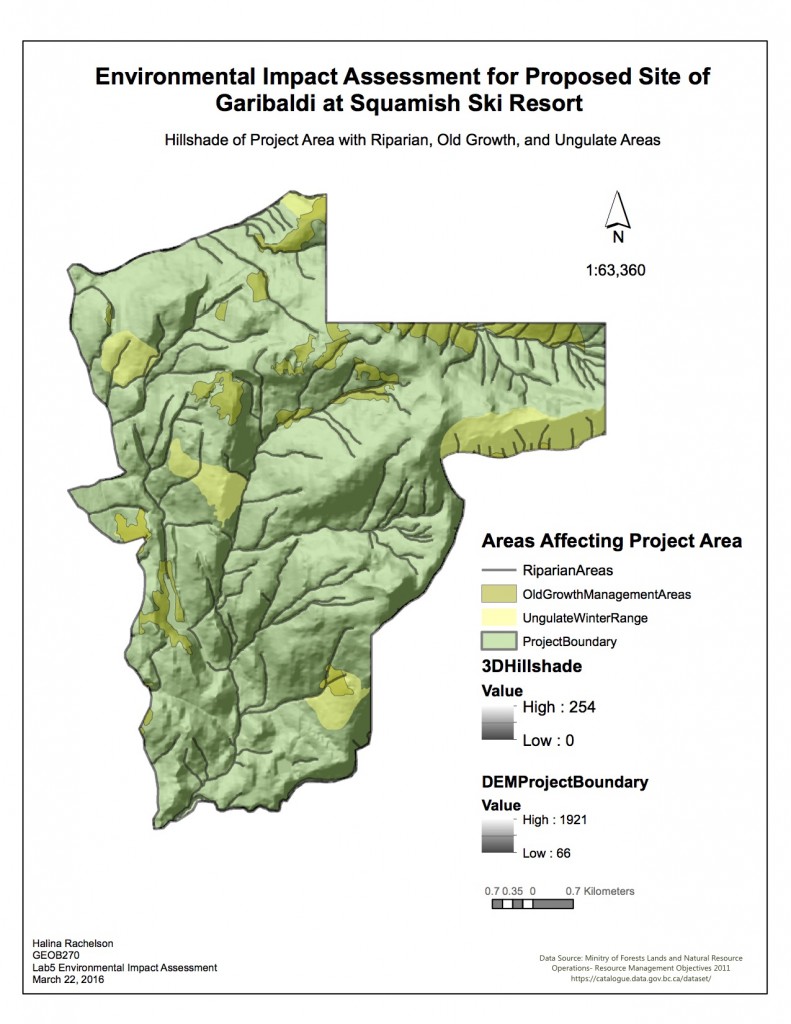- Conducted queries, proximity analysis, map algebra, and various other functions to approximate the environmental impact of a proposed ski resort project, Garibaldi at Squamish
Client Summary
The Garibaldi at Squamish project, which this analysis has covered, involves a proposed year-round ski resort location on Brohm Ridge. Tentatively, it includes 124 ski trails, 21 lifts, and associated resort accommodation and commercial development, with the ability to produce a total of 900 construction jobs in its 20-year building time frame and 2500 jobs during operation. As a natural resource planner, I have been tasked with reviewing the BC Environmental Assessment Office’s recommendation and the Resort Municipality of Whistler criticisms in order to determine whether the evidence is conclusive enough to oppose the proposed ski resort construction project. Thus, I have detailed below aspects of my ArcGIS analysis to conduct the environmental impact assessment that contributes to this evaluation:
- Clipped layers (using ArcToolBox Analysis tool) to situate Ungulate Winter Range and Old-growth management areas within the proposed project boundary;
- Categorized red-listed species from TEM layer using the Merge tool;
- Distinguished between rivers above and below 600 m. elevation to determine high and low elevation areas;
- Buffered low elevation rivers by 100 m. and high elevation rivers by 50 m, as low elevation rivers are more likely to be fish bearing, with multi-variable width buffer indicating fishery habitat;
- Applied Union tool to combine old growth management areas, endangered fish species habitat, and red-listed species into a combined protected areas layer;
- Applied the Dissolve function to avoid overlap and clipped the layer to the project boundary;
- Erased this protected layer from the site to demonstrate areas to avoid for this project’s development.
According to the calculations, the percentage of the total project area that will directly impact protected areas, including old growth forest, ungulate habitat, and red-listed ecosystem, rounds to around 52%. 10.6% of the project areas is below 600 meters. 6.8% would affect old growth management areas, 7.8% would affect ungulates, and 24.8% would affect red-listed species. The two greatest environmental concerns regarding the development of this project include the effects to flatmoss habitat, a red-listed species. In addition, the project could affect fishery habitat within riparian areas. As these particular species would face significant impacts from the project, it provides enough reason to oppose the construction of the ski resort. After conducting a variable width buffer of 50 m. in higher elevation areas, and 100 m. in lower elevation areas, the calculations show that 26% of the area within the project boundary would affect fishery habitat. It would be best to mitigate effects in low elevation riparian zones as streams below 600 m. are more likely to be fish bearing. Flatmoss habitat is also mostly found in these low elevation areas. Therefore to mitigate impacts of the project, it would be best to avoid these lower elevation areas. Overall, as sensitive habitat comprises a large enough area of the proposed project site, plans for construction should be delayed or even dissolved until more environmental impact mitigation measures are delivered.
- Ethical Considerations of Writing Memo for Proposed Project
Writing this memo led me to realize that conflicting opinions can stand in the way of making an environmental impact assessment decision. Personally, I believe that a huge project like a ski resort has systemic impacts, and so even if specific areas are perturbed by the project, other areas get affected in the landscape as well. For example, in my memo, it was suggested to avoid low elevation areas as these harbor more protected species. Nonetheless, even if higher elevation areas were built on for a ski resort, the upstream damage could trigger spillover effects downstream.

